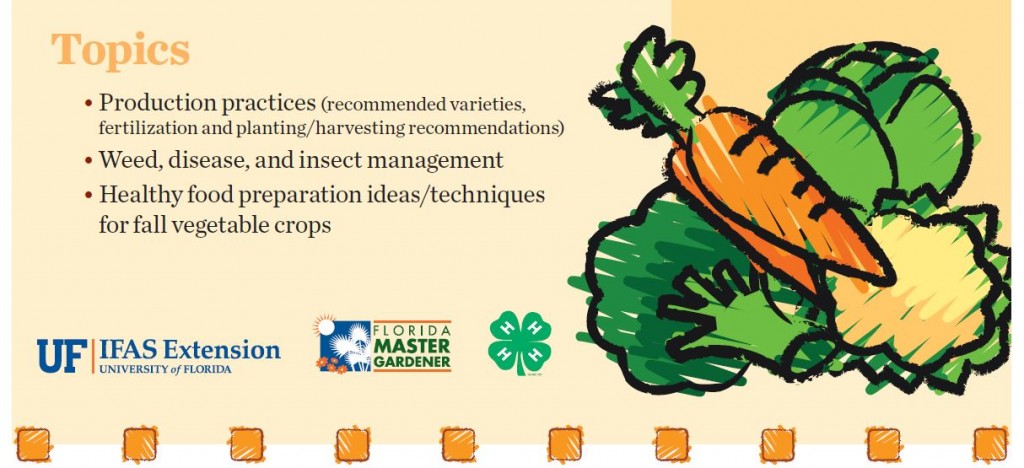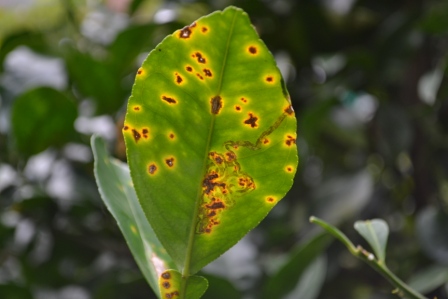
by Blake Thaxton | Nov 25, 2013
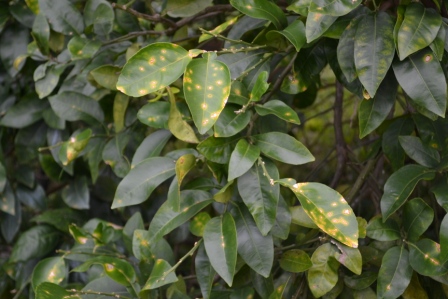
Citrus Canker lesions on leaves. Photo Credit: Beth Bolles, UF IFAS Extension – Escambia County
Authors: Blake Thaxton & Mary Derrick, UF/IFAS Extension – Santa Rosa Co. Mikaela Anderson, FDACS Division of Plant Inspection
Citrus canker is a serious disease of citrus trees that was recently confirmed for the first time in southern Santa Rosa County. Canker is caused by the bacterial pathogen Xanthomonas citri subsp. citri. Citrus canker has been a major pest of citrus in south and central Florida. It is economically damaging to the commercial industry and is also problematic to homeowners because it causes premature fruit drop, discolored fruit, and eventually causes the tree to become unproductive.
Canker was first introduced in 1912 into Florida and was declared eradicated in 1933. The disease was found again in the Tampa area on citrus in 1986. It was declared eradicated in 1994, but once again was found in 1995 in Miami. This time, the disease was not successfully eradicated in part because hurricanes made the disease too widespread to control. Despite its prevalence in south and central Florida, this disease has not been known in the Panhandle. The University of Florida and the Florida Department of Agriculture and Consumer Services’ Division of Plant Industry will be assessing the extent of the disease in Santa Rosa County in the coming months.

Lesions growing through the channels formed by the Citrus Leafminer insect. Photo Credit: Beth Bolles, UF IFAS Extension – Escambia County
How might you know if your citrus is infected by canker? One of the best indicators of canker is the presence of lesions, diseased spots, on the upper and lower surfaces of the leaves. The lesions will be raised and have a rough surface and will be surrounded by yellow halos. Similar lesions may be present on the fruit and stems as well.
[important]If you suspect that your citrus trees may have citrus canker please contact the Division of Plant Industry’s Helpline Center at 1-888-397-1517 before taking any action to reduce accidental spread of this disease. [/important]
before taking any action to reduce accidental spread of this disease. [/important]
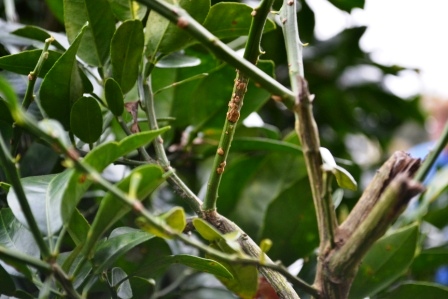
Lesions formed on the stems. Photo Credit: Beth Bolles, UF IFAS Escambia County Extension
The disease is highly contagious to citrus only and spreads rapidly through wind, rain and via people on their hands, clothes, and tools. Do not transport any plant material that shows symptoms of canker. Decontamination practices should be used when going from one citrus tree to the next. Hand washing with soap and water for 20 seconds or more to eliminate bacterium on the skin should be practiced as well as using alcohol-based hand sanitizer. Pruning tools or other tools that come into contact with citrus should be disinfected by a fresh solution of 1 ounce of household bleach to 1 gallon of water. An old or dirty bleach solution is not able to disinfect because the chemical is no longer active.
[warning]Do Not Move a Plant Infected with Citrus Canker. Please Call your local Extension Office for further instructions[/warning]
For more information on citrus canker:
(The University of Florida IFAS Citrus Canker website provides a photo gallery of disease symptoms & information about the disease)
by Mary Salinas | Nov 25, 2013
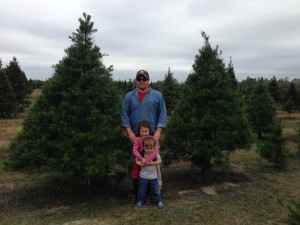
Whispering Pines Farm in Milton with proprietor Mike Kelly and children. Photo by Mary Derrick, UF IFAS.
One of the joys of this season is to bring home a fresh Christmas tree and enjoy the fragrance and natural freshness of a live tree inside your own home. Imagine how much fresher the tree would be if you harvested it!
The good news is there are Christmas tree farms in Northwest Florida where customers can choose and harvest their own Christmas tree! Visit the Florida Christmas Tree Association online to find the closest local Christmas tree farm. The website also offers information on tree varieties and how to care for harvested trees.
[notice] Here is a way to support your local farmer![/notice]
The varieties of trees grown in the panhandle are different from the northern trees brought south for the season. Christmas tree farms in the panhandle offer varieties such as Virginia pine, Leyland cypress, red cedar, Arizona cypress, Carolina sapphire, and Thuja “Green Giant’. Since these varieties do not grow naturally into the conical shape like northern-grown Christmas trees, the farmers take great care to train their trees into the traditional Christmas tree shape. Pruning and shaping the trees begins when they are about 2 years old and continues twice a year for as long as they are growing. The result is a tree that looks naturally shaped and ready for the tree stand.
Real Christmas trees are environmentally friendly as they are a renewable resource. Once trees are cut down, new ones are planted in their place. The trees are also reusable as mulch when chipped on-site or through county yard waste disposal services.
For additional information please see:
Christmas Trees and Their Care
Florida Christmas Tree Association
by Alex Bolques | Nov 25, 2013
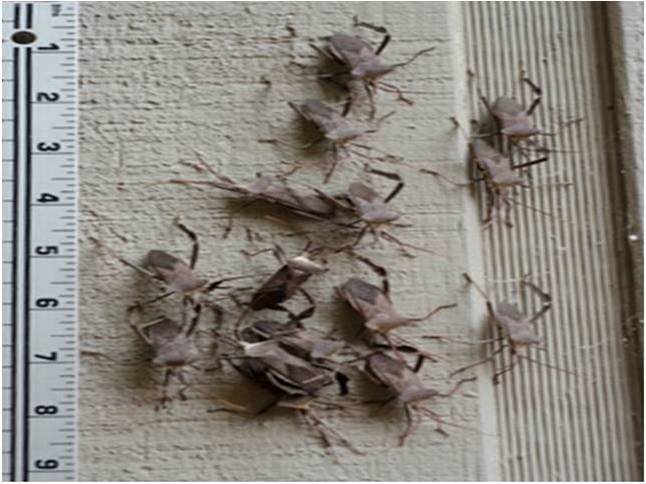
In search of an entry point into a home: Leaf footed bugs congregating on house siding in search of a warm sheltered environment to spend winter. Courtesy of Bill Stinson
Leaf footed bugs are pests of many seed, fruit, vegetable and nut crops. They get their name from the leaf shape of their back legs. The insect is dark brown to black and about an inch long. Like ladybird beetles, leaf footed bugs can invade your home in the fall in search of a warm sheltered environment to spend winter. In some cases, this may be inside your home. However, unlike ladybird beetles, which can invade a home by the hundreds, leaf footed bugs numbers are considerably less.
In both cases, they enter the home through openings such as cracks, crevices, crawl spaces, attics, ridge vents etc. Once inside, they do not cause any damage, eat, drink or reproduce. Instead, they go into what is called diapause, a dormant state. If you encounter them in living spaces of the home, a common management practice is to collect them by hand or mechanically by removing them with a vacuum cleaner and then releasing them outside. Leaf footed bugs are related to stink bugs and will give off an odor if crushed or held to long in your hand. Once spring arrives, they will become active and you may find them roaming around living spaces again. Use the same control tactic to help them find their way to the outside of the home.
It should be noted that ladybird beetles are considered a beneficial insect that feeds on crop-damaging insects such as aphids, mealy bugs, and white flies. On the other hand, leaf footed bugs are a serious pest of cotton and a direct pest of many seed, fruit, vegetable and nut crops.
Reference
Stink Bugs and Leaf-footed Bugs Are Important Fruit, Nut, Seed and Vegetable Pest

by Blake Thaxton | Nov 18, 2013

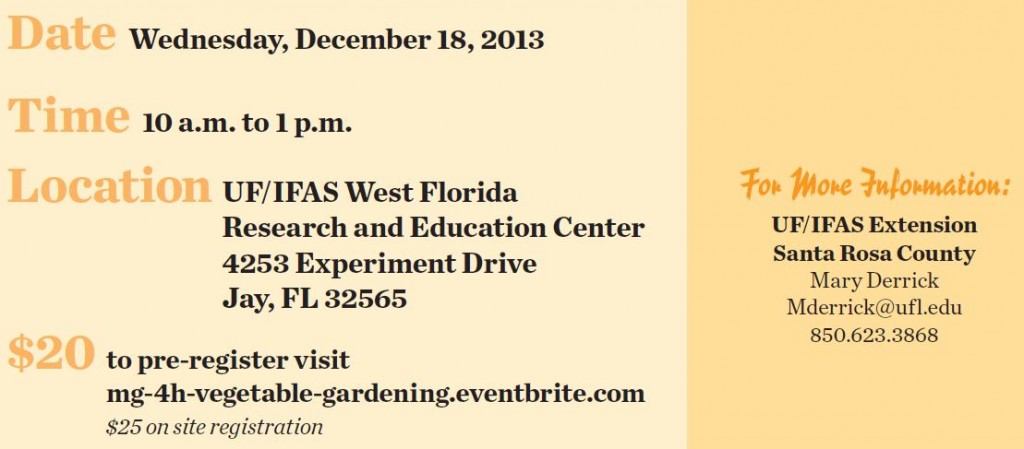

by Julie McConnell | Nov 18, 2013
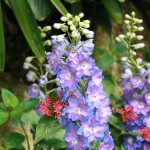
Delphiniums
As the weather changes, so should your flower bed. Annual flowers provide fantastic color to landscapes with months of flowers or attractive foliage, but the trade-off is that they give you all they’ve got over one growing season.
There are two main groups of annuals, summer (warm season) and winter (cool season). Summer annuals are considered “tender” and will not tolerate frosts, but winter annuals are “hardy” meaning they can stand cool temperatures and even hard frost if given time to establish before the coldest weather arrives. Most winter annuals actually prefer cooler temperatures and perform poorly during the hottest part of the year.
Some hardy winter annuals that can be planted after October are pansies, violas, snapdragons, dianthus,delphinium, petunia, alyssum, dusty miller, hollyhock, ornamental cabbage and kale, and verbena. With all the choices available, winter flower beds can be filled with all ranges of the color palate!
Plan to change flower beds to winter annuals from October to November, depending on the weather. Wait until cool weather trends arrive so that the new plants are not stressed by hot weather and high humidity. Most winter annuals will perform well until warm weather arrives, typically April or May in North Florida. Read more about “Gardening with Annuals in Florida.”










